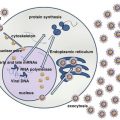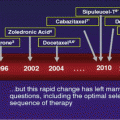Complete blood counts
Serum beta2-microglobulin
Serum albumin
Serum protein electrophoresis
Quantification of IgG, IgA, and IgM
Serum and urine immunofixation
Bone marrow biopsy and immunophenotypic studies
CT scan of the thorax, abdomen, and pelvis
Only when clinically indicated:
Serum viscosity
Fundoscopy
Coombs test
Cryoglobulins
Fat biopsy for amyloid
Anti-MAG, antiganglioside M1, and anti-sulfatide antibodies
WM is still an incurable disease, but the prognosis of the disease has improved over time with a median overall survival, which now exceeds 7 years [28]. Treatment of patients with asymptomatic WM is currently not recommended. Patients who need treatment are those with symptoms attributable either to tumor infiltration or to the IgM monoclonal protein. The size of the serum IgM monoclonal protein is not, per se, an indication to treatment [29].
Treatment recommendations from the VII International Workshop on WM have been recently published [30]. For the majority of patients, the most appropriate first-line treatment of WM is an immunochemotherapy including anti-CD20 monoclonal antibody rituximab. Since there are not randomized studies comparing different immunochemotherapeutic regimens, the choice of first-line therapy mainly depends on patient’s individual characteristics (e.g., age, performance status, comorbidities, eligibility to transplant) and disease’ presentation (e.g., peripheral cytopenias, hyperviscosity, bulky organomegalies, peripheral neuropathy). The combination of rituximab with cyclophosphamide and dexamethasone (DRC) is effective and well tolerated, either in young patients eligible to transplant or in elderly patients. A suitable alternative to this regimen is the association of rituximab and bendamustine, which seems particularly indicated for those patients who present with bulky disease or hyperviscosity, where a rapid disease control is needed. In these patients, also the combination of the proteasome inhibitor Bortezomib with rituximab is an appropriate choice, since it is associated with a rapid response. The combination of fludarabine, cyclophosphamide, and rituximab is no more considered a first-choice option due to its high short-term and late toxicity. For elderly patients not eligible to intravenous treatment, oral fludarabine or oral chlorambucil should be considered, the first agent being more effective, but associated with a higher incidence of neutropenia and infections. For patients with relapsed disease, a retreatment with the same regimen is reasonable if the duration of response was at least 12 months. Autologous stem cell transplant should be considered for patients with relapsed chemosensitive WM.
References
1.
Harris NL, Jaffe ES, Stein H, Banks PM, Chan JK, Cleary ML et al (1994) A revised European-American classification of lymphoid neoplasms: a proposal from the International Lymphoma Study Group. Blood 84(5):1361–1392PubMed
2.
Harris NL, Jaffe ES, Diebold J, Flandrin G, Muller-Hermelink HK, Vardiman J (2000) Lymphoma classification – from controversy to consensus: the R.E.A.L. and WHO classification of lymphoid neoplasms. Ann Oncol Off J Eur Soc Med Oncol/ESMO 11(Suppl 1):3–10CrossRef
3.
Swerdlow SHCE, Harris NL, Jaffe ES, Pileri SA, Stein H, Thiele J, Vardiman JW (2008) WHO classification of tumours of haematopoietic and lymphoid tissues. IARC Press, Lyon
4.
5.
Decaudin D, Lepage E, Brousse N, Brice P, Harousseau JL, Belhadj K et al (1999) Low-grade stage III-IV follicular lymphoma: multivariate analysis of prognostic factors in 484 patients – a study of the groupe d’Etude des lymphomes de l’Adulte. J Clin Oncol Off J Am Soc Clin Oncol 17(8):2499–2505
6.
Trotman J, Fournier M, Lamy T, Seymour JF, Sonet A, Janikova A et al (2011) Positron emission tomography-computed tomography (PET-CT) after induction therapy is highly predictive of patient outcome in follicular lymphoma: analysis of PET-CT in a subset of PRIMA trial participants. J Clin Oncol Off J Am Soc Clin Oncol 29(23):3194–3200CrossRef
7.
8.
Federico M, Bellei M, Marcheselli L, Luminari S, Lopez-Guillermo A, Vitolo U et al (2009) Follicular lymphoma international prognostic index 2: a new prognostic index for follicular lymphoma developed by the international follicular lymphoma prognostic factor project. J Clin Oncol Off J Am Soc Clin Oncol 27(27):4555–4562CrossRef
Stay updated, free articles. Join our Telegram channel

Full access? Get Clinical Tree





